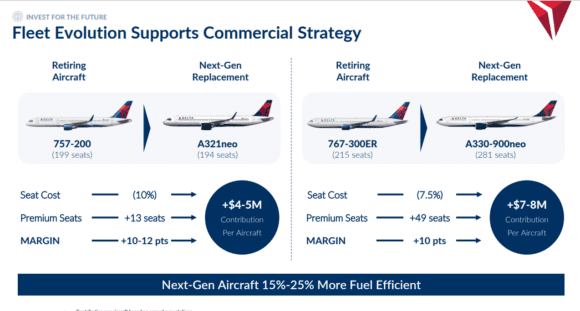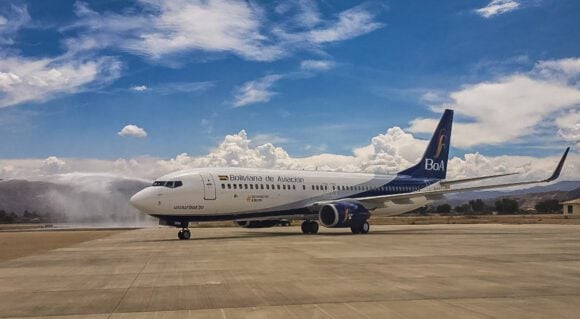
MG 7616 scaled
Delta Air Lines will leave the effects of the pandemic firmly in its rearview mirrors by the end of the year. “We call the end of 2023 the end of our restoration process. By the end of 2023, we will be higher in ASM capacity than in 2019,” President Glen Hauenstein said on Tuesday during the airlines’ Investor’s Day in Atlanta. Delta is almost done with the pandemic.
The carrier updated its revenue outlook for FY23 and now expects them to be up by 17-20 percent year-on-year compared to the previous guidance of 15-20 percent. Contributing factors are 17 percent higher capacity primarily by adding long haul, and lower fuel prices.
Total revenues will surpass $54 billion for the full year, up from $47 billion in 2019. In 2022, revenues were $50.6 billion.The guidance for 2024 is even higher at $60 billion, driven by robust demand, a growing GDP despite scenarios of recession, and higher income from loyalty programs. Total revenues per available seat mile (TRASM) will be flat to plus 3 percent year-on-year. Free cash flow should return to $3.0 billion this year and $4.0 billion in 2024 compared to $0.2 billion in 2022 and $4.3 billion in 2019. Delta expects to repay $4.0 billion in gross debt by the end of this year.
Premium cabins do very well
Delta’s premium cabins continue to see strong demand, a trend that started during the pandemic when it was thought that passengers selected premium for personal health reasons. But demand has remained strong, especially among frequent flyers. Delta expects to generate $19 billion in revenues from premium cabins this year, up from $15 billion in 2019. The share of premium within total revenues has increased from 32 to 35 percent and is expected to grow to 37 percent next year.
American Express’s remuneration to Delta is also seeing a continuous climb, reaching over $6.5 billion this year compared to $4.0 billion in 2019. The long-term goal is to reach $10 billion.
“When we get to the end of this year and the beginning of next year, we get something we haven’t had since the pandemic started. That is a good baseline to plan over,” said Hauenstein. “Two years ago, we had Omicron that ruined our first quarter and we couldn’t tell what demand would be. This Q1 was the first with stability. We can now look back and base our decisions on how we are going to place capacity and how to approach the market.”
Hauenstein said that Delta will maintain a careful approach when it comes to building back capacity, as it still sees some operational reliability issues and is confronted with late aircraft deliveries that are causing a lower growth rate. In 2024, capacity should grow by mid-single-digits, although the number of seats is still down on 2019 in some markets. This seat-restrained market will hugely benefit Delta’s revenues.
Regionals will take until 2025 to recover
The US domestic market is doing very well, except for the regionals. It will take probably until sometime in 2025 before capacity will have been restored, said Hauenstein, “so 2024 could be the beginning of the rebuild of the regionals.” However, he was very happy that Delta has captured the number 1 position in key hubs in Los Angeles, Boston, New York JFK and LaGuardia. The airline has made huge investments in its coastal gateways but is already seeing double-digit returns in what is a four-year plan. Next year, Delta will concentrate on rebuilding its four core hubs like Atlanta and Detroit.
The global network is also getting back strongly, not only since the pandemic but also thanks to previous strategy decisions and new partnerships with other airlines. The Pacific is set to produce record returns this thanks to the partnership with Korean Air and a more efficient fleet. Latin America has also significantly improved thanks to joint ventures with LATAM and Aeromexico.
The Transatlantic was a really challenging year, with “an unfortunate meltdown” of operations at Delta’s key European hubs in Amsterdam and Paris. “But I am glad to report they are back,” said Hauenstein.
Delta is seeing structural changes to travel patterns since the pandemic, something outlined earlier by United and American. “Where people want to fly is very different from pre-pandemic, but also when they want to buy, which is also different in terms of the booking curves. But we have a whole year with new-normal booking curves behind us and will use that to determine where we want to go in 2024.” Part of the travel pattern is determined by the Baby Boomers, “who don’t want to camp in Uganda but fly to the Four Seasons in Paris.”
Hauenstein also said he expects corporate travel will recover until the end of the year, but Delta will run its own surveys in the coming weeks to get a better understanding of their travel behavior.
Delta’s fleet should consist of 40 percent new technology and more-efficient aircraft and should get to 100 percent around 2030. The Boeing 757-200s and 767-300s will leave and be replaced by Airbus A321neo’s and A330-900s and A350-900s, which contribute $4 to $8 million per aircraft in better operating costs.
Views: 11




